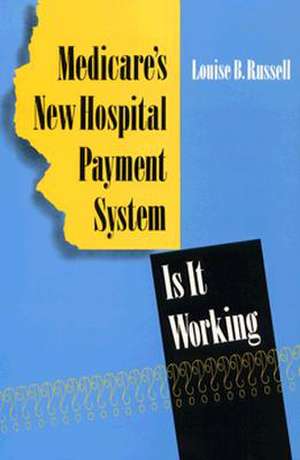Medicare's New Hospital Payment System: Is It Working?
Autor Louise B. Russellen Limba Engleză Paperback – sep 1989
In 1983 Congress changed the way Medicare pays for hospital care. Under the new prospective payment system, hospitals are paid a fixed rate, set in advance, to cover a patient's stay. If costs are less than the fixed rates, the hospital keeps the profit; if the costs are more, it absorbs the loss. From the beginning, prospective payment was recognized as a revolutionary change in Medicare. Congress wanted a system that would make federal expenditures more predictable and controllable, and expected hospitals to respond by becoming more efficient. Some observers have hailed it as a successful way to control the spiraling costs of the Medicare program. Others have criticized it as arbitrary and a threat to the health of the elderly.
In the six years since prospective payment was introduced, a substantial amount of evidence has accumulated about its effects. Russell looks at the major characteristics of the rate payment system, how it has changed the pattern of medical service, how these changes have affected the health of the beneficiaries, and the system's effects on Medicare outlays. She reviews what is known and what needs to be learned to arrive at a valid assessment of the system. Moreover, she contributes to the larger debate on Medicare by making what are frequently quite technical evaluations accessible to the general public.
In the six years since prospective payment was introduced, a substantial amount of evidence has accumulated about its effects. Russell looks at the major characteristics of the rate payment system, how it has changed the pattern of medical service, how these changes have affected the health of the beneficiaries, and the system's effects on Medicare outlays. She reviews what is known and what needs to be learned to arrive at a valid assessment of the system. Moreover, she contributes to the larger debate on Medicare by making what are frequently quite technical evaluations accessible to the general public.
Preț: 168.72 lei
Preț vechi: 177.61 lei
-5% Nou
Puncte Express: 253
Preț estimativ în valută:
32.28€ • 33.71$ • 26.72£
32.28€ • 33.71$ • 26.72£
Carte tipărită la comandă
Livrare economică 04-18 aprilie
Preluare comenzi: 021 569.72.76
Specificații
ISBN-13: 9780815776239
ISBN-10: 0815776233
Pagini: 128
Ilustrații: illustrations
Dimensiuni: 152 x 229 x 9 mm
Greutate: 0.19 kg
Editura: Brookings Institution Press
Colecția Brookings Institution Press
ISBN-10: 0815776233
Pagini: 128
Ilustrații: illustrations
Dimensiuni: 152 x 229 x 9 mm
Greutate: 0.19 kg
Editura: Brookings Institution Press
Colecția Brookings Institution Press
Notă biografică
Descriere
In 1983 Congress changed the way Medicare pays for hospital care. Under the new prospective payment system, hospitals are paid a fixed rate, set in advance, to cover a patient's stay. If costs are less than the fixed rates, the hospital keeps the profit; if the costs are more, it absorbs the loss. From the beginning, prospective payment was recognized as a revolutionary change in Medicare. Congress wanted a system that would make federal expenditures more predictable and controllable, and expected hospitals to respond by becoming more efficient. Some observers have hailed it as a successful way to control the spiraling costs of the Medicare program. Others have criticized it as arbitrary and a threat to the health of the elderly.
In the six years since prospective payment was introduced, a substantial amount of evidence has accumulated about its effects. Russell looks at the major characteristics of the rate payment system, how it has changed the pattern of medical service, how these changes have affected the health of the beneficiaries, and the system's effects on Medicare outlays. She reviews what is known and what needs to be learned to arrive at a valid assessment of the system. Moreover, she contributes to the larger debate on Medicare by making what are frequently quite technical evaluations accessible to the general public.
In the six years since prospective payment was introduced, a substantial amount of evidence has accumulated about its effects. Russell looks at the major characteristics of the rate payment system, how it has changed the pattern of medical service, how these changes have affected the health of the beneficiaries, and the system's effects on Medicare outlays. She reviews what is known and what needs to be learned to arrive at a valid assessment of the system. Moreover, she contributes to the larger debate on Medicare by making what are frequently quite technical evaluations accessible to the general public.
